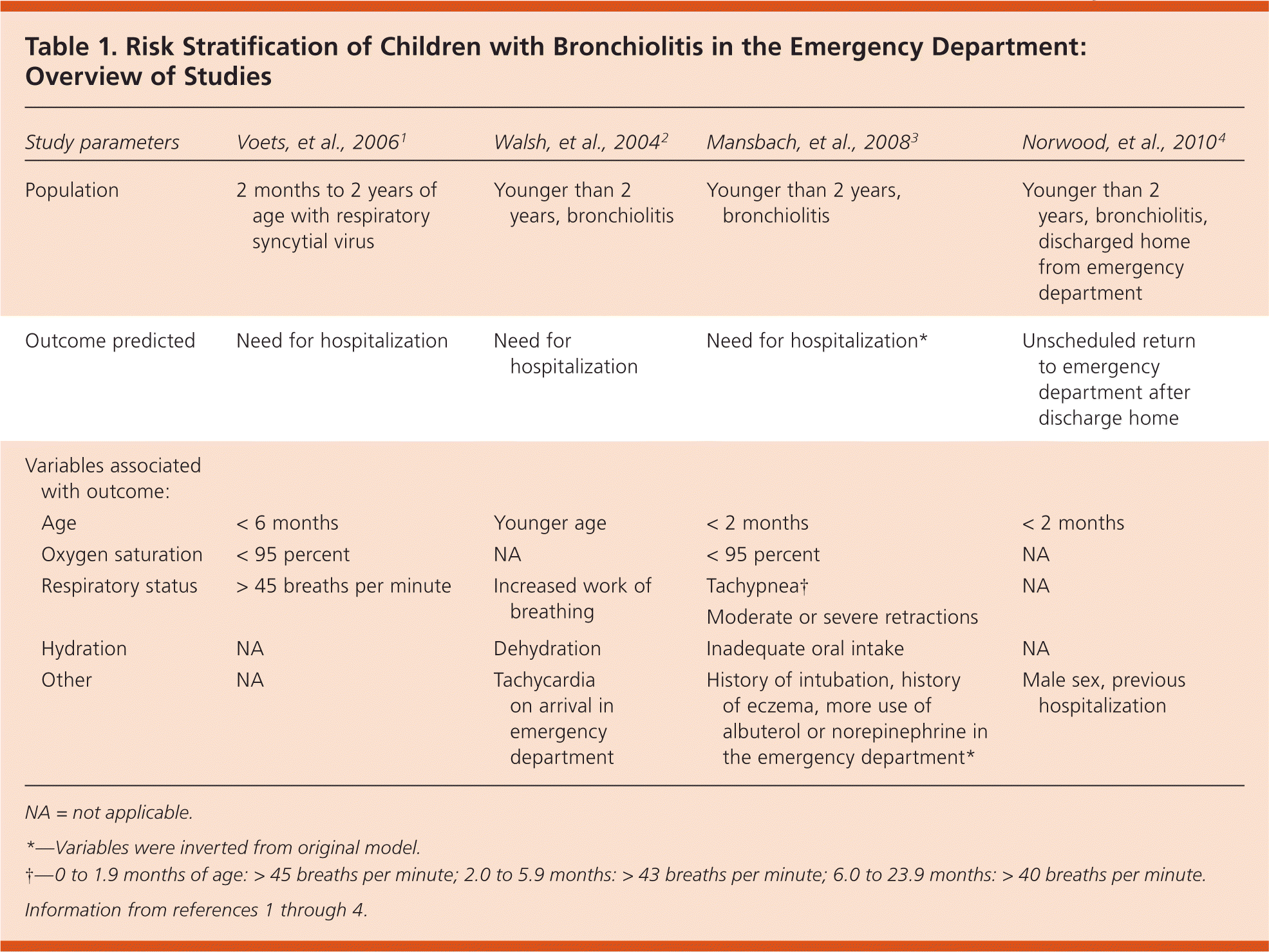
Am Fam Physician. 2012;86(3):275-279
Author disclosure: No relevant financial affiliations to disclose.
Clinical Question
Which signs and symptoms best predict the need for hospitalization or failure of outpatient therapy in children with bronchiolitis?
Evidence Summary
Bronchiolitis is a common and sometimes serious viral lower respiratory tract infection in young children. It is characterized by tachypnea, wheezing, and low-grade fever. Although some children require hospitalization, others can be safely managed at home with careful supervision and follow-up. Several groups of researchers have attempted to develop and validate clinical decision rules to identify children with bronchiolitis who are at risk of complications. The ideal rule would be simple to use and prospectively validated in a new group of children to demonstrate its accuracy and generalizability.
A Belgian study identified 378 otherwise healthy children two to 24 months of age with respiratory syncytial virus in the emergency department.1 The attending physician admitted 117 of the children (31 percent) to the hospital. Three variables predicted the need for admission: age younger than six months, oxygen saturation less than 95 percent, and a respiratory rate greater than 45 breaths per minute. The study is limited by lack of multivariate analysis and failure to prospectively validate these predictors.
An Irish study was better designed, using 118 episodes of bronchiolitis in 99 children at one hospital to develop a clinical prediction rule, and then 182 infants at another hospital to validate the rule.2 All children were younger than two years of age, and any child with clinically diagnosed bronchiolitis was included. A clinical rule was developed to predict the need for hospitalization (the decision was made by the resident and confirmed within 24 hours by the senior attending physician). However, the rule is only moderately accurate and is complex to calculate.
A U.S. multicenter study set out to determine which children with bronchiolitis need to be admitted to the hospital, and among children discharged home from the emergency department, which are at risk of an unscheduled return visit. The study initially identified 1,456 children younger than two years in the emergency department with clinically diagnosed bronchiolitis (i.e., rhinitis, tachypnea, wheezing, cough, crackles, use of accessory muscles, and/or nasal flaring). The first phase of the study developed a clinical decision rule to predict the need for hospitalization, which occurred in 619 children (43 percent).3 The researchers used a split-sample approach, randomly assigning patients to a derivation or validation group. Significant predictors of successful discharge home included age of at least two months, no history of intubation or eczema, absence of tachypnea, no or mild retractions, initial oxygen saturation of 94 percent or greater, adequate oral intake, and less use of albuterol or norepinephrine in the emergency department (a cutoff for “less use” was not given). The second phase of the study included 717 of the children who were discharged home, of whom 121 (17 percent) had an unscheduled return visit within six months (most within two days of their initial evaluation).4 Predictors of unscheduled return included age younger than two months, male sex, and previous hospitalization. Oxygen saturation and tachypnea were not significant predictors because children with abnormal values were typically admitted. Neither phase of the study presented clinical prediction rules in a form that could be used at the point of care, such as a point score, algorithm, or nomogram.
Although there is no single, easy-to-use, well-validated model for bronchiolitis risk stratification, there are some important take-home messages from these four studies (Table 1).1–4 Four variables suggesting higher risk are shared among two or more models: younger age (all four models), especially younger than two months; oxygen saturation less than 94 to 95 percent; dehydration or oral intake; and tachypnea or increased work of breathing. Previous hospitalization and intubation are also important predictors of complications. It is therefore important to carefully evaluate each of these factors, and strongly consider hospitalization in children with bronchiolitis and any of these factors.

| Study parameters | Voets, et al., 20061 | Walsh, et al., 20042 | Mansbach, et al., 20083 | Norwood, et al., 20104 | |
|---|---|---|---|---|---|
| Population | 2 months to 2 years of age with respiratory syncytial virus | Younger than 2 years, bronchiolitis | Younger than 2 years, bronchiolitis | Younger than 2 years, bronchiolitis, discharged home from emergency department | |
| Outcome predicted | Need for hospitalization | Need for hospitalization | Need for hospitalization* | Unscheduled return to emergency department after discharge home | |
| Variables associated with outcome: | |||||
| Age | < 6 months | Younger age | < 2 months | < 2 months | |
| Oxygen saturation | < 95 percent | NA | < 95 percent | NA | |
| Respiratory status | > 45 breaths per minute | Increased work of breathing | Tachypnea† | NA | |
| Moderate or severe retractions | |||||
| Hydration | NA | Dehydration | Inadequate oral intake | NA | |
| Other | NA | Tachycardia on arrival in emergency department | History of intubation, history of eczema, more use of albuterol or norepinephrine in the emergency department* | Male sex, previous hospitalization | |
Applying the Evidence
An otherwise healthy six-week-old, term boy presents with tachypnea for his age (respiratory rate of 50 breaths per minute) and oxygen saturation on room air of 92 percent. He is not dehydrated and is taking oral fluids well. What is the next step?
Answer: Because of his risk factors (i.e., young age, male sex, tachypnea, and low oxygen saturation), you admit him to the hospital for observation.
